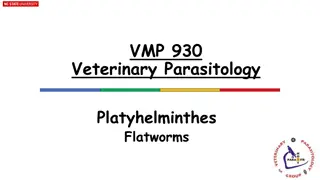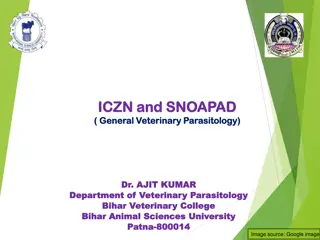Understanding Parasitic Relationships in Medical Parasitology
Medical Parasitology delves into the intricate relationships between parasites and their hosts, encompassing symbiosis, mutualism, commensalism, and parasitism. The success of a parasite hinges on achieving a delicate balance with its host, avoiding expulsion or harm. Various types of parasites are described, including ectoparasites and endoparasites, each with unique characteristics and impacts. The roles of definitive hosts, intermediate hosts, and vectors are elucidated, shedding light on the transmission and survival strategies of parasites. Overall, the field of parasitology investigates the multifaceted interactions between parasites and hosts, crucial for understanding and addressing parasitic diseases.
Download Presentation

Please find below an Image/Link to download the presentation.
The content on the website is provided AS IS for your information and personal use only. It may not be sold, licensed, or shared on other websites without obtaining consent from the author. Download presentation by click this link. If you encounter any issues during the download, it is possible that the publisher has removed the file from their server.
E N D
Presentation Transcript
Medical Parasitology Assistant Professor Dr. Ahmed A. Mohammed Your Textbook is: Animal Agents and Vectors of Human Diseases 5th Ed. P.C. Beaver & R.C. Jung.
Medical Parasitology Introduction and definitions
Type of relationships Symbiosis: Is the relationship between two unsimilar organisms that are adapted to living together, and the associates called symbionts. This association may be beneficial or harmful to either of the association. Mutualism: Is termed tosymbiotic association that is beneficial to both parties. Commensalism: Is the relationship when one of the associated organisms is benefited and the other is neither benefited nor harmed. Parasitism: Is the relationship when one (the parasite) lives in or on the other at the expense of the latter (the host). The parasite: Is the organism which depends on other living organism in its feeding, housing, and transportation, this organism called (the host). The host may either not be harmed or may suffer the consequences of this association, a parasite disease.
*The successful parasite should reach a precise equilibrium with its host so that each tolerates the other. If the balance is disturbed, the host may spontaneously expel or destroy the parasite, or, on the other side, the association may become so harmful to the host which lead to the infection and the parasite deposit as a consequence. *Parasites that cause harm to the host called pathogenicparasites while those that benefit from the host without causing any harm to their hosts known as commensals. Ectoparasites: Areorganisms that live on or in the skin of their hosts, and the relationship called infestation. Most parasitic arthropods belong to this category. Endoparasites: Are the parasites of the digestive tract, extraintestinal organs and tissues, and those that are intracellular within the host, and produce infection, irrespective of their size. Obligateparasites: the parasites that are entirely dependent on their hosts. Facultative parasites:arecapable of living either free or in or on a hosts.
Definitive host:An organism in which the adult or final stage of a parasite develops. Intermediate host: the host in which an intermediate or larval stage develops. Paratenichost:is the host in which the parasite is transported and neither gains nor loses infectivity for its definitive host. Vectors: are transmitters of parasites from host to host. If the transmitter is not essential to the life cycle, it is a mechanical vector; if it is essential, it is a biologic vector. Reservoir host: Is an animal species on which the parasite depends for its survival in nature and serves as a source of infection for other susceptible host, including man. Zoonosis: is the term applied to a disease of animals when it is transmitted to man; this may be a common or an incidental occurrence. *The parasites has developed physiologic and biochemical adaptations needed for its new associations. The continued existence of a parasite as a species is dependent on adaptations for reaching and entering its host as well as maintenance of its position within the host once it has arrived. Parasitology isthe science which studies the parasites from all its life aspect. *Parasites that injure their hosts called pathogens, while the development of this damage is pathogenesis.
The degree of injury to the host depends on variety of factors, including: 1. The potential virulence of the agent (its essential pathogenicity). 2. The amount of inoculum. 3. The rapidity with which it may multiply in host tissues. 4. The site of inoculation. 5. The type of exposure, whether it is single or repeated exposure. 6. The tolerance or resistance of the host to the particular strain of the agent, and the general threshold of resistance of the host. The type of damage caused by the parasites: The type of damage produced may be primarily: 1. Mechanical. 2. Lytic (enzymatic). 3. Toxic. 4. Allergic in nature. 5. The lesion produced by the parasite may open a way for the bacteria and other pathogens to enter the tissue.
Symptoms: Are the manifestations of pathological processes resulting from the effects of the agent. *In some parasitosis the host may be essentially unresponsive. *In other instances the host may generate specific antibodies that counteract the antigens introduced by the foreign agent, or may wall off the invader or its products by cellular infiltration, proliferation and differentiation. *The host response may be essentially local at the site of injury or it may include system humoral or cellular changes. *A person may carry a parasitic infection that is transmissible to others, yet himself show no related signs or symptoms. This person is called a carrier. Epidemiology: It is the science concerned with the factors that determine the prevalence of infection and the incidence of disease. It is the history of the disease, including infection in man and animals and agents that serve as reservoirs and vectors.
Prevalence: Representing the number of infected individuals at a given time in a designated area. Incidence: Is the rate or frequency of disease (new infection) occurs. *If the infection maintains itself in a human community, it is endemic. *If there is high prevalence, it is hyperendemic; *If the infection appears irregularly in scattered individuals, it is sporadic; and if it develops a high prevalence through unusually rapid transmission, it is epidemic. *Many examples on parasitism are found among the groups of lower organisms, such as the viruses, rickettsiae, bacteria, fungi and spirochetes. However, parasitism varies widely with respect to the degree of adaptation,
Parasitic infections, Pathogenesis and immunity: *Parasitic infections are associated with a broad spectrum of effects. Some are due to the parasites themselves and others are a consequence of the host response to the invader. *The nature and extent of the pathological effects are dependent upon the site and mode of infection and also on the level of the parasite burden. *The development of protective immunity to such parasites is more complicated than that to bacteria and viruses because of the complicated life cycles of the parasites involved. *As with other infectious agents, the site occupied by a parasite is important. For instance, a host will survive with a large number of lung flukes (Paragonimus spp.) in the lungs, but infection in the brain may cause far more serious effects. *The severity of disease depends not only on the degree of the infection but also on the physiological state of the host. A lowering of general health, due to malnutrition for example, predisposes to more serious consequences following infection by parasites. * The physical obstruction of anatomical sites leading to loss of function can be a major component of the diseases caused by parasites. The intestinal lumen can be blocked by worms such as Ascaris lumbricoides or tapeworms, and filarial parasites (Wuchereria bancrofti and Brugia malayi) can obstruct the flow of lymph through lymphatics.
*Intestinal infection with the tapeworm Taenia solium is usually of little consequence, but the eggs may develop into larvae (cysticerci) in humans, causing cysticercosis. The cysticerci can be found in the muscle, liver, eye or, most dangerously, the brain. Hydatid cysts, the larval stage of the dog tapeworm (Echinococcus granulosus) in man, may reach volumes of 1 2 L, and such masses can cause severe damage to an infected organ. *Another type of pathogenicity may be represented by the physiologicaleffects. The large numbers of Giardia spp. covering the walls of the small intestine can lead to malabsorption, especially of fats. *Competition by parasites for essential nutrients leads to host deprivation. Thus, depletion of vitamin B12 by the tapeworm Diphyllobothrium latum sometimes leads to pernicious anaemia. *Immunoparasitology: is a branch of immunology that deals with the human parasites and their hosts immune response. Immunopathology: Many helminth parasites are long-lived and causes chronic infections. The immune response that develops during this time often proceeds to cause pathologic changes that in many helminth infections are the primary cause of disease. A well-studied example of this is the granulomatous reaction that isolate schistosoma eggs.
Immune responses that prevent infection with helminths: A prevalent theme of resistance to helminths is that of premunition or concomitantimmunity, a state wherein the host is protected from further infection with a given species by ongoing persistent infection with the same organism. There are at least two explanations for this type of immunity. 1. In one scenario, parasites of the primary infection induce an immune response that, while incapable of killing them, is nevertheless able to kill incoming parasites that may cause a superinfection. 2. A second explanation is that the primary infection alters the anatomy or physiology of the host in such a way that it becomes more difficult for incoming larval organisms to establish infection in the appropriate niche. *Killing of helminths by eosinophils via antibody-dependent cellular cytotoxicity (ADCC) is an attractive and widely cited mechanism for resistance to parasitic worms. Vaccine development: The application of antihelminth vaccines is more advanced in veterinary medicine than in human medicine, with a history of the use of attenuated vaccines against certain nematode parasites and more recently the development of recombinant protein and DNA vaccines against the sheep tapeworm Taenia ovis.
Immune evasion: It is the mechanism by which the parasite escape the host immune response by mimic its structural molecules to disguise the immune system of the host and prevent the recognition of its antigens. The long-term survival of helminth parasites within mammalian hosts indicates that they have developed sophisticated mechanisms to evade the cytotoxic effects of the immune response. Living parasites are able to modulate their surface structure in a way that prevents recognition. Prominent among these is the expression of transforming growth factor receptor family members by helminths.























